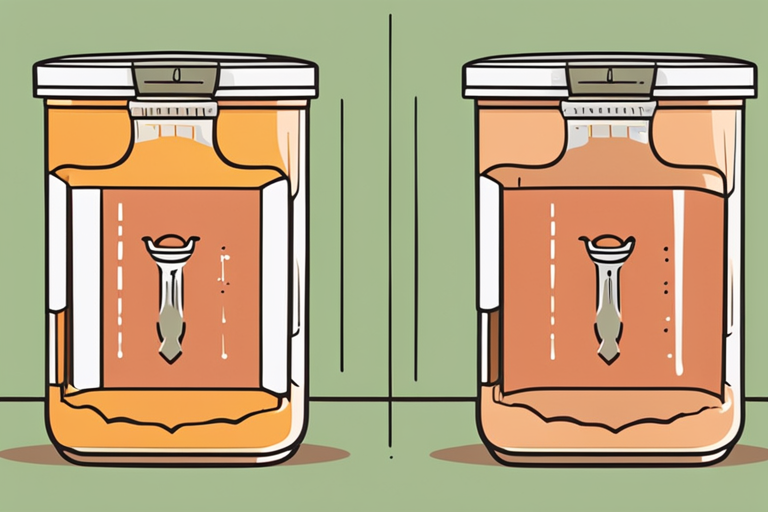
How Long Does Beef Broth Last After the Expiration Date?
Get Your Free Food Safety Cheat Sheet
30 most common foods with instant answers. Print it and stick it on your fridge—completely free!
# How Long Does Beef Broth Last After the Expiration Date?
When it comes to food safety, understanding expiration dates is crucial. Beef broth is a pantry staple for many households, but what happens if you find an old container in the back of your cupboard? In this blog post, we will explore how long beef broth lasts after the expiration date and provide tips on how to safely store and use it.
## Understanding Expiration Dates on Beef Broth
Expiration dates on food products, including beef broth, indicate the manufacturer's estimate of how long the product will remain at its peak quality. However, it's important to note that these dates are not always set in stone. Here's what you need to know about expiration dates on beef broth:
### Types of Expiration Dates
- **"Best By" Date:** This date is an indicator of when the beef broth is expected to be at its best quality in terms of flavor and texture. Consuming the broth after this date does not necessarily mean it is unsafe.
- **"Use By" Date:** This date is a recommendation for when the beef broth should be used by for the best quality. Consuming the broth after this date may pose some risks.
### Factors Affecting Shelf Life
Several factors can impact the shelf life of beef broth, including:
- **Storage Conditions:** Proper storage is essential for prolonging the shelf life of beef broth.
- **Packaging:** The type of packaging can also affect how long the broth remains fresh.
- **Temperature:** Storing beef broth at the recommended temperature can help extend its shelf life.
## How Long Can Beef Broth Last After the Expiration Date?
While it's always best to follow the manufacturer's guidelines, beef broth can often be consumed safely after the expiration date. Here are some tips to help you determine if your beef broth is still good to use:
### Signs Your Beef Broth Has Gone Bad
- **Unusual Odor:** If the broth smells off or has a sour odor, it is likely spoiled.
- **Mold:** Any signs of mold growth indicate that the beef broth is no longer safe to consume.
- **Off Color:** If the broth has changed color or appears cloudy, it should be discarded.
- **Strange Texture:** Any changes in texture, such as sliminess or unusual consistency, are indicators of spoilage.
### How to Safely Use Expired Beef Broth
If your beef broth has passed the expiration date but shows no signs of spoilage, you can still use it safely by following these guidelines:
1. **Perform a Visual and Smell Check:** Inspect the broth for any signs of spoilage, such as mold or off odors.
2. **Heat it Thoroughly:** Boiling the broth before consuming can help kill any potential harmful bacteria.
3. **Use it in Cooking:** Using expired beef broth in cooked dishes where it will be heated to a safe temperature can reduce the risk of foodborne illness.
## Proper Storage of Beef Broth
To maximize the shelf life of beef broth and ensure its safety, proper storage is essential. Here are some tips for storing beef broth correctly:
### Tips for Storing Beef Broth
- **Refrigeration:** Once opened, store beef broth in the refrigerator and consume it within the recommended time frame.
- **Freezing:** Beef broth can be frozen for longer-term storage. Divide it into smaller portions for easy thawing.
- **Air-Tight Containers:** Transfer any leftover broth to airtight containers to prevent contamination and maintain freshness.
- **Labeling:** Always label containers with the date the broth was stored to track its shelf life.
## Real-Life Scenarios
Many people can relate to finding an old container of beef broth buried in the back of their pantry. Consider Jennifer, who discovered a can of beef broth that had expired two months ago while cleaning out her kitchen. Instead of tossing it out immediately, she recalled reading about expiration dates and decided to inspect it closely. After confirming it had no signs of spoilage, she used it to make a hearty vegetable soup. The soup turned out delicious, proving that sometimes, what seems like waste can still be valuable.
Another example is Mark, who was preparing for a big family dinner and realized he was out of beef broth. While digging through his cupboard, he stumbled upon a carton that was just past its "best by" date. Initially hesitant, he remembered the guidelines about expiration dates. After checking for any off smells and ensuring it looked fine, he used it as a base for his famous chili. The result? A comforting dish that delighted his entire family, who never guessed he almost tossed out the broth.
### A Third Story: Emma's Cooking Adventure
Then there's Emma, a college student who loved experimenting in the kitchen but was often on a tight budget. One day, while making a stir-fry, she noticed that her beef broth had expired a week ago. Remembering her mom's advice about trusting her senses, she gave it a quick sniff, and to her relief, it smelled just fine. She used it to add depth to her dish, and her friends were none the wiser. Emma learned an important lesson: expiration dates can sometimes be more flexible than we think!
## Scientific Context
Understanding how bacterial growth occurs can help demystify expiration dates. Beef broth is typically rich in protein, making it an ideal medium for bacteria if mishandled. The USDA notes that most bacteria thrive at temperatures between 40°F and 140°F (4°C and 60°C)—the so-called "danger zone." If broth has been stored correctly and not left out for extended periods, it may still be safe to consume after the expiration date, but it requires careful inspection.
The canning process of commercial beef broth effectively neutralizes bacteria and extends its shelf life significantly. However, once opened, it becomes exposed to new bacteria from the air and other surfaces, which is why refrigeration and proper storage are crucial.
### Nutritional Insights
Beef broth is not just a flavorful base for soups and sauces; it also offers some nutritional benefits. It is rich in amino acids, particularly glycine and proline, which are essential for collagen production in the body. These nutrients can be beneficial for joint health and skin elasticity. However, when consuming expired broth, it's essential to remember that some of these nutrients may degrade over time, particularly if the broth is stored improperly or for extended periods.
## Practical Tips for Using Beef Broth
Here are some actionable tips to get the most out of your beef broth:
1. **Make Ice Cubes:** Pour leftover broth into ice cube trays and freeze. This way, you can easily add small amounts to dishes without thawing an entire container.
2. **Check Seals:** Before using canned broth, ensure the can is well-sealed and not bulging. A compromised seal can indicate contamination.
3. **Cook Once, Check Twice:** If you're using broth in a recipe that requires long cooking times, like stews, you're generally safe, but always do a quick taste test before serving.
4. **Don't Rely Solely on Dates:** Many people don’t realize that sensory checks (sight, smell, taste) are as important, if not more, than the printed date.
5. **Use as a Marinade:** Expired beef broth, if it passes visual and smell checks, can work wonders as a marinade for meats. It can infuse flavors and help tenderize the meat.
6. **Add to Grains:** Mix some broth into grains like rice or quinoa while cooking for added flavor and nutrition. This is especially handy if you're using broth that is nearing its expiration.
## Common Mistakes in Handling Beef Broth
1. **Ignoring Storage Guidelines:** One common mistake is not refrigerating opened broth promptly or leaving it out on the counter for too long. Remember, once opened, it should be treated like any perishable food.
2. **Not Labeling:** Failing to label containers can lead to confusion about the age of your broth, making it easy to overlook a perfectly good product.
3. **Cooking with Spoiled Broth:** Some may think that boiling will always kill any bacteria in spoiled broth. While boiling does kill most pathogens, certain toxins are heat-stable and can still cause illness.
4. **Using Broth from Damaged Packaging:** If you notice any dents, bulges, or leaks in the packaging, it's best to err on the side of caution and discard the broth.
## Expert Insights
Food safety experts recommend using your senses to assess food quality. Dr. Marion Nestle, a renowned professor of nutrition, food studies, and public health, emphasizes that understanding how long food can last beyond its expiration is essential in reducing food waste. She suggests that with broth, it’s particularly important to trust your nose—if it smells off, it’s better to be safe than sorry.
### Recommendations from Food Safety Authorities
The FDA and USDA both encourage consumers to be vigilant about food safety while also being practical. They advise checking foods like beef broth for spoilage signs, even if they are technically still within their expiration dates. This approach not only promotes safety but also helps in making the most of your food, reducing waste, and saving money.
## Conclusion
In conclusion, beef broth can often be safely consumed after the expiration date, provided it shows no signs of spoilage. By understanding expiration dates, proper storage techniques, and how to assess the quality of beef broth, you can make informed decisions about using it in your recipes. Remember to trust your senses and follow food safety guidelines to enjoy your beef broth safely.

Authoritative Food Safety References
These agencies and university labs inform every tip and health precaution we publish.
USDA FoodKeeper – Cold Storage Guidelines
Official refrigerator, freezer, and pantry timelines maintained by the U.S. Department of Agriculture.
Visit USDA FoodKeeperFDA Produce Safety Rule & Grower Guidance
Field-to-fridge handling practices that prevent contamination of fruits, vegetables, and leafy greens.
Visit FDA Produce SafetyCDC Foodborne Illness Prevention Hub
Surveillance-backed guidance on pathogens, symptoms, and steps to reduce foodborne illness risk.
Visit CDC Food SafetyUC Davis Postharvest Technology Center
University research detailing optimal storage atmospheres for produce after harvest.
Visit UC Davis PostharvestPenn State Extension – Home Food Preservation & Safety
Peer-reviewed extension bulletins on safe canning, chilling, and reheating practices.
Visit Penn State ExtensionCan you freeze beef broth to extend its shelf life?
How can I tell if beef broth has gone bad?
Can I still use beef broth if it has been left out at room temperature?
How should beef broth be stored to maximize its shelf life?
Get Your Free Food Safety Cheat Sheet
30 most common foods with instant answers. Print it and stick it on your fridge—completely free! Want more? Upgrade to the complete guide with 70+ foods.
Scan your food directly and get instant safety info using our AI-powered camera feature.